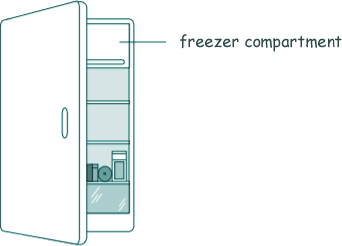Heat Questions - GCSE Level Q17. The diagram shows a fridge with a freezer compartment. The temperature of the air inside the freezer compartment is –5 °C
(a) The air inside the fridge forms a convection current when the fridge door is closed. Explain why. Air near freezer compartment at the top of the fridge is cooled (or loses energy).
[4 marks] (b) The table below shows information about four fridges.
A householder concludes that the energy used in one year is directly proportional to the volume of the fridge. Explain why her conclusion is not correct. Use data from the table in your answer. If they were proportional then if volume was doubled, energy use would also double. or volume ÷ energy would be a constant ratio. This is not the case as 500 is 2×250 but 630 is not 2×300 or similar use of data. [2 marks] (c) New fridges are more efficient than fridges made twenty years ago. Give one advantage and one disadvantage of replacing an old fridge with a new fridge. Ignore the cost of buying a new fridge. Advantage on from:
Disadvantage one from:
[2 marks] (8 marks total) |
Follow me...
|






